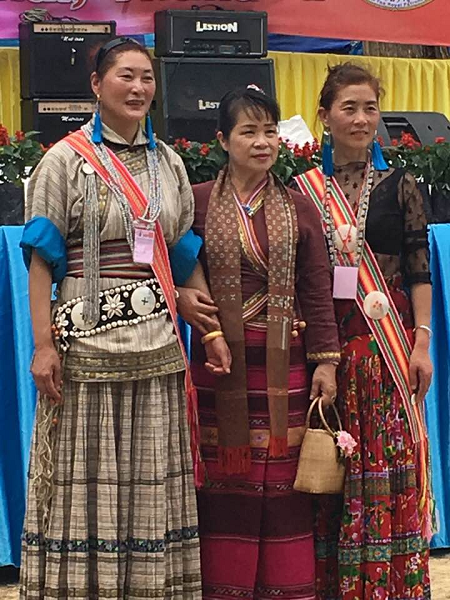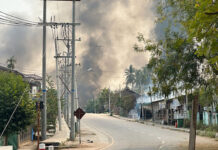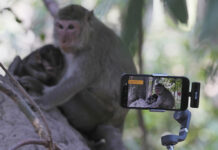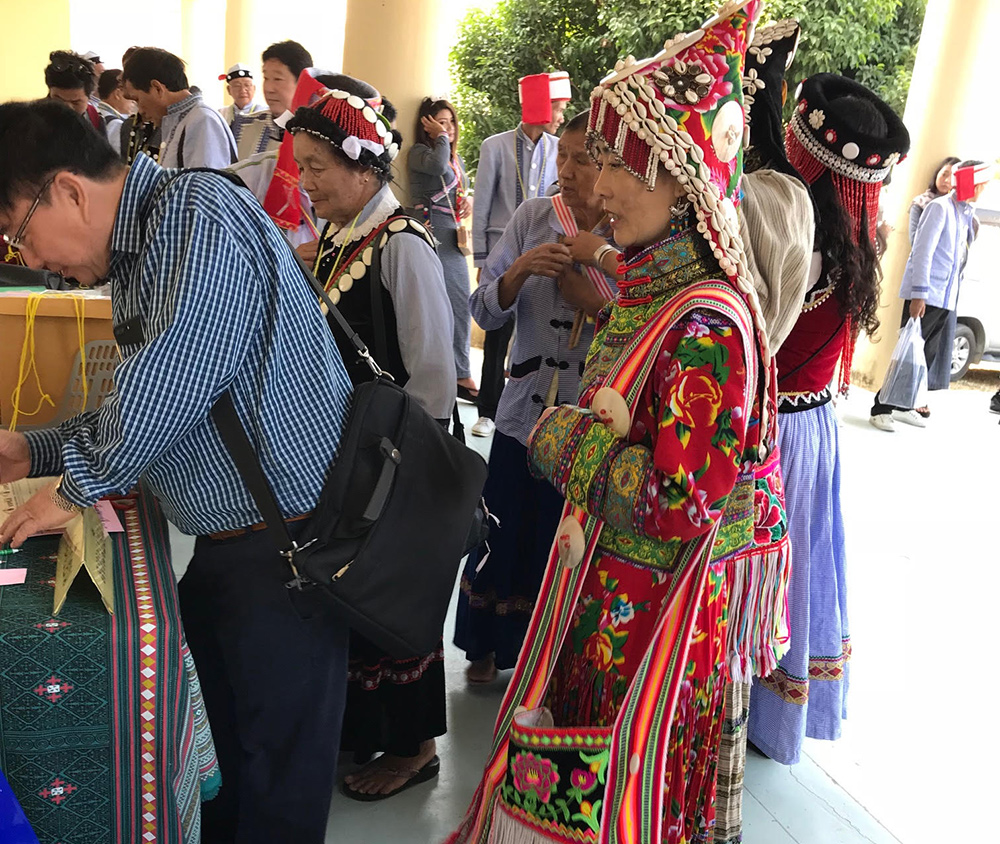By Michele Zack
Naively, I arrived on time to day one of a three-day meeting about a hill tribe’s cultural development only to find a deserted hall.
What to expect? No idea. A draft schedule had been circulated only days before, so I did not know who would be speaking or even my role. Two months earlier, I had accepted a vague invitation from a Lisu contact to “please join us.”
Within an hour after starting time however, the organizers of Friday’s international meeting on “Lisu Cultural Inheritance and Sustainable Development” were in place at the Municipality Convention Hall in Chiang Mai’s Mae Taeng district. Soon colorful clouds of people began wafting in.
Lisu women, dripping with beads and silver, lived up to their reputation as the most and eye-catching of hill women in traditional and updated finery from China, Myanmar, India and Thailand.
Read: From Struggle to Success, Lisu Hill Tribe Enters the 21st Century
The men weren’t far behind. They wore custom jackets of blue-stripped Lisu fabric decorated with black velvet, cowry shells, bone buttons or the Lisu symbol of manhood – the crossbow – embroidered on the lapel. Some carried actual crossbows.
But the main accessories were headgear – from the traditionally beaded to more eclectic cowboy hats, turbans and sports caps, not to mention the shoulder bags.
I’m here from California to introduce my book, “The Lisu: Far from the Ruler,” which was published in December.
Researched on and off over a 20-year period, I take a broad look at the 1.5 million-strong minority group dispersed across Thailand, China and Myanmar – with a few in India and Laos. The result is a mini-study in globalization, a time-lapse narrative in book form.
The Friday meeting was part of two events. The conference was attended on two mornings by about 200 Lisu leaders from five countries, and indigenous and foreign scholars. The larger festival down the road in a Lisu village was attended by a few thousand.

At the formal conference, mundane Lisu concerns over myi-do (repute), crop portfolios, and marrying off daughters are set aside to tackle the existential matters of cultural survival. The Lisu have only recently begun developing long-term strategies to fend off the demise of their language and culture. A parade of speakers, beginning with Atapah Sinlee, event organizer, insist that not just national divisions – but cultural and religious ones – must be overcome if the Lisu are to survive. This transnational Lisu Unity movement has picked up steam only in the last 10 years, greatly aided by social media.
The Lisu have taken to Facebook, Lisu Zone website and WeChat in China to reach across borders. They are using digital tools as the means of getting together and organizing for the first time.
I know this is true, because in the short period since publication of my book, I have gone from having three Lisu Facebook friends to several hundred. Lisu have networked to an astonishing degree. While they have been slower than other minorities to take up higher education in general, the internet is a milieu in which they thrive.
A few talks are held on Lisu history, which is traced back 3,000 years by a female Chinese anthropologist and Burmese Lisu scholar now resident in the US state of Minnesota. These stir up pride, but agenda item one of this meeting is the future. Speaker after speaker sound the alarm about the impending loss of Lisu language literacy, and several offer ideas and strategies on how to avoid language loss and the demise of the culture it would cause.

The missionary Fraser developed a Lisu script 100 years ago, but because it was used for religious purposes, the animists, Buddhists and other non-Christians were resistant to learning it. Instead, as Lisu began attending schools, they learned Thai, Burmese, or Chinese writing systems. Lisu in Myanmar, 80 percent of whom are Christian, are by far the most literate Lisu, and unlike in every other country where this minority lives, children there are taught to read and write Lisu in both government and religious schools.
But, beginning with China, Fraser’s script has now been universally accepted by governments as the Lisu writing system. In 2009, it was adopted for international keyboard software standards by the UNICODE Consortium. Several speakers, Christian or not, academic or otherwise, made passionate pleas for the Lisu themselves to accept it, and to encourage and incentivize children (and even adults) to learn it as the best, and perhaps only, safeguard to ensure that Lisu language and culture will exist in 50, or even 20 years.
Other themes of the conference supporting this main one were education and economic development. Lisu entrepreneurs such as Chome Orn-anong exhorted her kinsmen and women to climb up the value added ladder by developing products and services to sell, as she has with her Abino Coffee Company. Before, farmers in her village of Doi Chang, Thailand’s oldest Lisu settlement (that today has an Akha majority), were receiving just 40 baht or 50 baht a kilo for this labor intensive crop, with middlemen reaping most of the profits. Now that she has researched and improved her product, acquired roasting expertise and developed a business plan, growers in her collective are receiving many times that price.
That was just the morning.
Having taken up such weighty topics, the second and larger part of the international began in the afternoon – a giant party attended by a couple thousand Lisu. It was a three-day celebration of cross-border Lisu-ness that unfolded at a temporary encampment 20 minutes from Mae Taeng near Dton Loong village. There was food, purveyors of culture, handicrafts, educational exhibits, the Abino Coffee Company and tickets being sold for a raffle tickets organizers hoped would pay for the conference.
Lunch was served by an army of cheerful women delivering dozens of dishes of remarkably fresh, home-style Lisu food to a hundred tables. Now, finally, we can have some fun! I enjoyed talking with other Lisu scholars, such as Masao Ayabe from Tokyo Metropolitan University who has been coming to Thailand to study the Lisu for 30 years.
I met the Indian Lisu scholar Avía who has written a Lisu dictionary, and is now completing a Lisu-English Dictionary. A Malaysian PhD Candidate from Cornell, Ting Hui Lau, shared her experience of two years of field work with the Lisu in the Upper Salween Valley inn Yunnan, China.
My mentor the Dutch anthropologist Otome Hutheesing, fluent in Lisu and now well into her 80s, is in heaven. She accompanied me to Yunnan in the 1990s, and we reminisced. Otome’s Lisu daughter Mimi Saeju brought us all together. By the end of lunch, hundreds of women and men were circle dancing to music provided by Lisu musicians at the center of our rustic dining hall. The heavier feelings of the morning’s conference lifted in this demonstration of Lisu community
The afternoon and evening were full of commerce, visiting, music and dancing, including some stunning performances by a pair of women, famous Chinese Lisu singers. As it got dark, the old Thai Lisu man who set up a mobile still to cook up a sour rice mash began offering “liquor medicine” to all and sundry. It drips off a string into a container below, thick, sour, and alcoholic.
This is a bit of a cultural test of the new Lisu Unity movement, I think, as most Christian Lisu have given up drinking and are not known to be flexible or tolerant on this score. However, the evening is extraordinarily mellow, we witness little public drunkenness, and the Christians seem as happy as everyone else to be here at this major gathering of the clans.
The old Lisu proverb, sometimes a war cry Shu ma da! or “We can never die!” comes to mind. It sometimes translated as “Never say die!”
For this to become prophecy, Lisu children today must learn not only to shout it with typical Lisu bravado while at play in imaginary battles – but also to write it.
Correction: Due to an editing error, an earlier version of this story incorrectly identified the Lisu as being majority Christian. That is only true in some areas.

















































